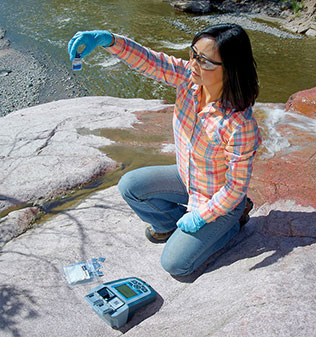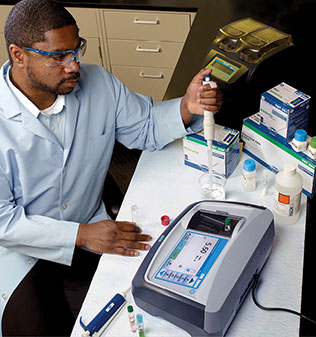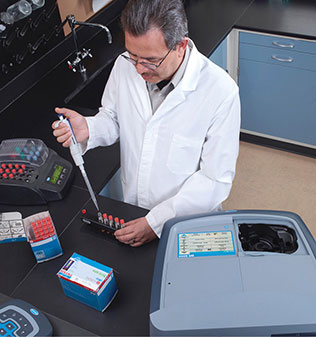-
PRODUCTS
- Lab Instruments
- Lab Meters and Probes
- Chemistries, Reagents, and Standards
-
Online Analyzers
Ammonium Analysers Ammonia Monochloramine Chlorine Analyzers
- CL17sc
- CL10sc Amperometric
- 9184 sc Amperometric
- เครื่องวิเคราะห์คลอรีนด้วยการวัดสี Ultra Low Range CL17sc
EZ Series Analysers- Iron
- Aluminium
- Manganese
- Phosphate
- Chloride
- Cyanide
- Fluoride
- Sulphate
- Sulphide
- Arsenic
- Chromium
- Copper
- Nickel
- Zinc
- Ammonium
- Total Nitrogen
- Total Phosphorus
- Phenol
- Volatile Fatty Acids
- Alkalinity
- ATP
- Hardness
- Toxicity
- Sample Preconditioning
- Boron
- Colour
- Nitrate
- Nitrite
- Silica
- Hydrogen Peroxide
- EZ Series Reagents
- EZ Series Accessories
- EZ sc Series Inorganics
- EZ sc Series Metals
- EZ sc Series Nutrients
-
Online Sensors and Controllers
Ammonium Sensors Conductivity Sensors
- 3400 Analogue Contacting
- 3400 Digital Contacting
- 3700 Analogue Inductive
- 3700 Digital Inductive
- 9525 DCCP System
- Industrial UV
- Flow and Collections
- Automated Lab Systems
- Test Kits & Strips
- Microbiology
- Lab Equipment and Supply
- Samplers
- Electrochemistry
- PARAMETERS
- APPLICATIONS
- INDUSTRIALS
- E-SHOP
- Service
- BRANDS
Hach Thailand
เลือกประเทศหรือภูมิภาคของคุณ:
Europe
Americas
Asia - Australasia
- Australia
- Mainland China
- India
- Indonesia
- Japan
- Malaysia
- New Zealand
- Philippines
- Singapore
- South Korea
- Thailand (Thai)
- Taiwan
- Vietnam
Middle East - Africa
Chemistries ONLINE SHOP: +6693 769 9254
UV/VIS สเปคโตรโฟโตมิเตอร์
สำหรับห้องปฏิบัติการ / ภาคสนาม
UV/VIS สเปคโตรโฟโตมิเตอร์ สำหรับห้องปฏิบัติการ / ภาคสนาม
การทดสอบคุณภาพน้ำที่คุณวางใจได้ทุกครั้ง
เป็นไปตามกฎระเบียบและการดำเนินงานของโรงงาน
เป็นเวลากว่าครึ่งศตวรรษที่ Hach® เป็นพันธมิตรของคุณในการวิเคราะห์น้ำด้วยเครื่องวัดสเปกโตรโฟโตมิเตอร์ โดยมี:
- วิธีการวิเคราะห์ที่ได้รับอนุมัติที่หลากหลายที่สุด
- มีระบบการป้องกันขอผิดพลาดที่มาพร้อมตัวเครื่อง
- ใช้ร่วมกับสารเคมีของ Hach ได้
- มีให้เลือกทั้งแบบพกพาและห้องปฏิบัติการ เพื่อตอบสนองทุกการใช้งานและตามงบประมาณที่จัดสรรไว้
สเปคโตรโฟโตมิเตอร์คืออะไร
เครื่องวัดสเปกโตรโฟโตมิเตอร์เป็นเครื่องมือที่ใช้วัดปริมาณแสงที่ตัวอย่างน้ำดูดกลืนเมื่อแสงผ่านเข้าไป
หลังจากเติมสารเคมีลงในตัวอย่างน้ำ รีเอเจนต์เหล่านั้นจะทำปฏิกิริยากับสารที่วิเคราะห์เพื่อสร้างสารเชิงซ้อนของสี เครื่องวัดสเปกโตรโฟโตมิเตอร์จะใช้การสอบเทียบภายในเพื่อเทียบสีนั้นกับความเข้มข้นของพารามิเตอร์ที่กำลังวัด
การวัดค่าสเปกโตรโฟโตเมตรีเป็นวิธีที่ใช้กันทั่วไปและมีประโยชน์มากที่สุดวิธีหนึ่งในการวิเคราะห์เชิงปริมาณของพารามิเตอร์น้ำจำนวนมากในการใช้งานทางอุตสาหกรรมและเทศบาลต่างๆ
ชนิดของสเปคโตรโฟโตมิเตอร์
เลือกเครื่องสเปกโตรโฟโตมิเตอร์สำหรับห้องปฏิบัติการแบบพกพาหรือแบบตั้งโต๊ะ (VIS หรือ UV-VIS) ของ Hach ร่วมกับรีเอเจนต์ของ Hach เพื่อความถูกต้องและการประกันคุณภาพน้ำที่เหมาะสมที่สุด

สเปคโตรโฟโตมิเตอร์แบบพกพา
เครื่องวัดสเปกโตรโฟโตมิเตอร์แบบพกพาช่วยให้คุณวิเคราะห์ตัวอย่างน้ำในภาคสนามได้
หากคุณใช้งานในสภาพแวดล้อมนอกพื้นที่เป็นหลัก เครื่องวัดสเปกโตรโฟโตมิเตอร์แบบพกพาของ Hach จะให้คุณภาพและความแม่นยำในการตรวจวัดของคุณในแพ็คเกจที่ทนทาน กะทัดรัด และใช้งานง่าย

เครื่องสเปคโตโฟโตมิเตอร์สำหรับใช้ในห้องปฏิบัติการ
สเปกโตรโฟโตมิเตอร์ในห้องปฏิบัติการจะวัดค่าการดูดกลืนแสงในช่วงที่มองเห็นได้ของสเปกตรัมแม่เหล็กไฟฟ้า เหมาะอย่างยิ่งสำหรับความต้องการการวิเคราะห์น้ำปริมาณมาก
เครื่องวัดสเปกโตรโฟโตมิเตอร์แบบตั้งโต๊ะที่ใช้งานง่ายของเราได้รับการตั้งโปรแกรมสำเร็จรูปมากกว่า 250 วิธีที่เหมาะสำหรับการวิเคราะห์น้ำในห้องปฏิบัติการ

เครื่องวัดสเปกโตรโฟโตมิเตอร์สำหรับห้องปฏิบัติการในช่วง UV-VIS
สเปกโตรโฟโตมิเตอร์ในห้องปฏิบัติการ UV-VIS จะวัดการดูดกลืนแสงตลอดช่วงอัลตราไวโอเลตและช่วงที่มองเห็นได้ของสเปกตรัมแม่เหล็กไฟฟ้า
เครื่องมือ UV-VIS ของเรามีขั้นตอนที่เป็นแนวทางและรวมถึงวิธีการทดสอบที่ตั้งโปรแกรมไว้ล่วงหน้าและซอฟต์แวร์การประกันคุณภาพแบบบูรณาการของเรา – Claros™, The Water Intelligence System จาก Hach

คุณสมบัติของผลิตภัณฑ์สเปคโตรโฟโตมิเตอร์
สเปคโตรโฟโตมิเตอร์แบบพกพา
สเปคโตรโฟโตมิเตอร์แบบพกพา รุ่น DR1900
ด้วยอินเทอร์เฟซผู้ใช้ที่เรียบง่ายซึ่งทำให้การทดสอบง่ายกว่าที่เคย DR1900 จึงมีความแม่นยำและพกพาสะดวกที่สุดในระดับเดียวกัน
DR1900 น้ำหนักเบาและกะทัดรัด สร้างขึ้นเพื่อการใช้งานในสภาพที่สมบุกสมบัน และมีความยืดหยุ่น โดยยอมรับขนาด Vial ที่หลากหลาย
นอกจากนี้ยังรวมวิธีการที่ตั้งโปรแกรมสำเร็จรูปที่ผ่านการทดสอบโดยทั่วไปแล้วกว่า 220 รายการที่ติดตั้งไว้แล้ว
สเปคโตรโฟโตมิเตอร์แบบพกพา รุ่น DR1900 พร้อม USB+Power Module
รวม DR1900 Portable Spectrophotometer ของคุณเข้ากับ USB และ Power Module (LZV813) เพื่อให้สามารถถ่ายโอนข้อมูล(ตัวเลือกเสริม)
ด้วยวิธีการที่ตั้งโปรแกรมสำเร็จรูปกว่า 220 วิธีในการออกแบบที่กันน้ำและทนทาน DR1900 ให้ผลลัพธ์ที่มีคุณภาพในห้องปฏิบัติการด้วยเครื่องมือแบบพกพาที่พร้อมใช้งานภาคสนาม
ซื้อตอนนี้สเปคโตรโฟโตมิเอตร์สำหรับห้องปฏิบัติการ
สเปคโตรโฟโตมิเตอร์รุ่น DR3900 ที่ไม่มีเทคโนโลยี RFID*
DR3900 แบบตั้งโต๊ะ (320 - 1100 นาโนเมตร) สเปกโตรโฟโตมิเตอร์แบบลำแสงแยกพร้อมวิธีการที่ตั้งโปรแกรมสำเร็จรูปมากกว่า 220 วิธีซึ่งปรับให้เหมาะสมสำหรับการวิเคราะห์น้ำในห้องปฏิบัติการ กระบวนการที่ปลอดภัย และผลลัพธ์ที่แม่นยำ
เครื่องมือนี้เชื่อมต่อกับ Claros™ ซึ่งเป็นนวัตกรรมระบบ Water Intelligence ของ Hach ช่วยให้คุณเชื่อมต่อและจัดการเครื่องมือ ข้อมูล และกระบวนการได้อย่างราบรื่น ทุกที่ทุกเวลา
ซื้อตอนนี้สเปคโตรโฟโตมิเตอร์รุ่น DR3900 ที่มีเทคโนโลยี RFID*
รับเทคโนโลยีที่ได้รับการพิสูจน์แล้วของสเปกโตรโฟโตมิเตอร์ DR3900 พร้อมด้วยเทคโนโลยี *RFID (การระบุความถี่วิทยุ)
เทคโนโลยี RFID สามารถติดตามขวดตัวอย่างที่มีสมาร์ทแท็กได้อย่างง่ายดายด้วยระบบ Hach RFID sample-ID ขจัดการปะปนของตัวอย่าง และให้ความสามารถในการติดตามตัวอย่างที่ดีขึ้น
ซื้อตอนนี้เครื่องวัดสเปกโตรโฟโตมิเตอร์ UV-VIS
DR6000™ UV VIS สเปคโตรโฟโตมิเตอร์ แบบไม่มีเทคโนโลยี RFID
UV-VIS สเปกโตรโฟโตมิเตอร์ แบบตั้งโต๊ะ (190 - 1100 นาโนเมตร) ที่ให้การสแกนความยาวคลื่นความเร็วสูงทั่วทั้งยูวีและสเปกตรัมที่มองเห็นได้
ในฐานะที่เป็นแล็ปสเปกโตรโฟโตมิเตอร์ที่ล้ำหน้าที่สุดในอุตสาหกรรม ตัวเครื่องมาพร้อมกับวิธีการที่ตั้งโปรแกรมสำเร็จรูปไว้มากกว่า 250 วิธี เครื่องมือนี้ยังเชื่อมต่อกับ Claros™
ซื้อตอนนี้DR6000™ UV VIS สเปคโตรโฟโตมิเตอร์ แบบมีเทคโนโลยี RFID
คุณประโยชน์ทั้งหมดของสเปกโตรโฟโตมิเตอร์ DR6000 ร่วมกับเทคโนโลยี *RFID (การระบุความถี่วิทยุ).
RFID แจ้งให้คุณทราบโดยอัตโนมัติเมื่อชุดทดสอบหมดอายุ ความต้องการการทดสอบน้ำและสิ่งแวดล้อมของคุณ ทั้งหมดนี้รวมอยู่ในเครื่องวัดสเปกโตรโฟโตมิเตอร์เครื่องเดียว
ซื้อตอนนี้Frequently Asked Questions
What is the difference between a colorimeter and a spectrophotometer?
Colorimeters (also referred to as Filter Photometers) and Spectrophotometers both measure sample absorbance to determine analyte concentrations. Colorimeters are usually portable and use LED light sources and color filters. As a result, they operate at fixed wavelengths and can only accommodate tests that incorporate those wavelengths.
Spectrophotometers are usually bench top instruments and use light sources that can produce a range of wavelengths. The spectrophotometers used by Hach use tungsten (or xenon) lamps to produce light in the visible spectrum and deuterium lamps to produce UV light. Spectrophotometers also use monochromators to select for a desired wavelength. As a result, spectrophotometers can be used for a broad range of tests.
The following table highlights the differences between Colorimeters and Spectrophotometers:
| Colorimeter (Filter Photometer) | Spectrophotometer |
|
| Light Source | LED, Fixed Wavelength | Lamp (Tungsten, Xenon, Deuterium), Wavelength Range |
| Wavelength Selector | Color Filter, Fixed Wavelength | Monochromator, Wavelength Range |
| Portability | Stationary parts, light weight, good for field use | Moving parts, heavier, good for bench use. The DR1900 can be used in the field. It is lighter and battery operated, but still has some moving parts. |
| Parameters | Single or Limited Number of Parameters determined by Fixed Wavelengths | Numerous Parameters determined by the Wavelength Range. |
How is a calibration curve prepared in a colorimeter or spectrophotometer?
Hach colorimeters and spectrophotometers are carefully calibrated during manufacturing and do not require additional calibration. However, most of these instruments have user-entered calibration options for colorimetric tests if desired.
To calibrate an instrument for a particular test, put the instrument in absorbance mode, select the wavelength for the test, and prepare 3 to 10 different concentrations of standard solutions that span the full test range. Follow the Hach procedure (or your own procedure) to develop color in each standard, and the measure the absorbance of each standard in the instrument.
Most Hach instruments can record the absorbance and concentration of each standard, and then calculate a calibration curve. Refer to the instrument manual for instrument specific instructions. After the instrument is calibrated, it will calculate the concentration of unknown samples using the calibration curve.
What is the difference between the DR3900 and DR6000 Spectrophotometers?
The DR6000 spectrophotometer has a UV lamp while the DR3900 spectrophotometer does not. As a result, there are more programs on the DR6000 than on the DR3900.
The DR6000 has a Carousel Holder 7 x 1 cm (Product # LZV902.99.00002) and a Carousel Holder 5 x 1 inch (Product # LZV902.99.00012), which can be purchased as optional accessories.
The DR6000 also has optional software applications which are not available on the DR 3900. These include the Brewery Analysis Package (Product # LZV942), the Drinking Water Analysis Package (Product # LZV925), and the Enzymatic Food Analysis Software (Product # LZV943).
The DR6000 has tighter specifications than the DR3900. For example, the wavelength accuracy of the DR6000 is ± 1 nm. The wavelength accuracy of the DR3900 is ± 1.5 nm.
What is the factor to convert from PO4 to PO4-P?
To convert from units of orthophosphate (PO43-) to orthophosphate as phosphorus (PO4-P), multiply the value by 0.3261. To convert from orthophosphate as phosphorus (PO4-P) to orthophosphate (PO43-) divide the value by 0.3261.
Many Hach spectophotometers and colorimeters give the option to change the chemical form of the reported value. This number is a ratio of the atomic mass of the elements in the chemical form. This calculation does not change the concentration of phosphorus in the sample, it only changes the value in relation to the units it is expressed in.
For example: Changing a height from 6 feet to 72 inches, or to 183 cms, does not change the actual height, it only changes the units in which it is reported. They are all mathematically equivalent.
Are the DR3900 and DR6000 spectrophotometers compatible with WiFi/WLAN?
The spectrophotometer has a wired ethernet connection out of the box. In order to connect a DR3900 or DR6000 spectrophotometer to a WiFi Network/WLAN, a USB adapter must be used. Hach does not carry an adapter; however, adapters based off of RealTek RTL8187, such as Netgear WG111v3 and Trendnet TEW-424UB H/W:3.1R have been found to work.
Does Hach have an ultra-low range iron procedure for spectrophotometers?
Iron, Total FerroZine® Method, Method 10287_DOC316.53.01520 measures ultra-low range iron using FerroZine® and a standard 1" square glass sample cell on the DR3900, DR5000, or DR6000.
Why does a spectrophotometer need to be zeroed?
Spectrophotometers and colorimeters are zeroed or "blanked" to reset the absorbance baseline to any background color in the sample that may absorb at the wavelength in question causing an interference.
What is the advantage of using RFID with spectrophotometers?
The Radio Frequency Identification (RFID) system is designed to deliver accurate results by supporting the operator from sampling to sample preparation, sample analysis and documentation. By means of RFID technology one can trace samples completely back to the sampling point.
Lot number and expiry date information of the TNTPlus™ tests are logged into the spectrophotometer thanks to the 2D barcode. The RFID module reads out and displays all batch specific information from the test box. The batch certificate can be printed out immediately from the spectrophotometer using a printer.
Which instruments are compatible with TNT+ vials?
The DR1900, DR3900, and DR6000 are compatible with TNT+ chemistries.
To verify vial compatibility with any instruments please verify that the instrument is listed in the Instrument-specific information table in the full version of the method document.
Can the temperature of a sample affect a colorimetric test?
Yes this is possible. For example, a colder temperature could slow the chemical reaction and cause low results. Most methods are completed accurately when the sample temperature is between 20 and 25 ° C (68 to 77 °F).
Methods which are extremely temperature sensitive will have a note regarding any special temperature requirements in the full procedure.
What is the enclosure rating for Hach Spectrophotometers and Colorimeters? Enclosure ratings are denoted with an IP code that designates the resistance of an instrument to dust and water intrusion.
The first digit signifies the resistance to solid particles while the second digit signifies the resistance to liquid ingress. An "X" in the IP rating signifies the enclosure was not rated for that specification.
As an example, an IP-67 rating means that an instrument is dust proof and is waterproof for up to 30 minutes at a depth of 1 meter. Included in this article is a table of IP ratings for Hach Spectrophotometers and Colorimeters.
| Instrument | Rating | Other Information |
| DR 6000 | IP-20 | With the sample cell compartment closed |
| DR3900 | IP-40 | Excluding USB and Ethernet Ports and power supply |
| DR1900 | IP-67 | With the sample cell compartment closed |
| DR5000 | IP-31 | |
| DR3800 | IP-3X | |
| DR2800 | IP-41 | With the sample cell compartment closed, IP-42 with Protective Cover in place |
| DR2700 | IP-41 | |
| DR800 | IP-67 | |
| DR900 | IP-67 | Including the USB port. USB port should not be used when wet. |
| PCII | IP-67 | Excluding the battery compartment |
What information do the DR3900 and DR6000 Spectrophotometers read on the TNT+ boxes with RFID?
The TNT+ box includes updates to the calibration factors, including zero factors, as well as the Certificate of Analysis (COA). This information is read by DR3900 and DR6000 Spectrophotometers via RFID.
Which Hach spectrophotometers can read ultraviolet wavelengths?
The DR6000 UV VIS Spectrophotometer is the only current Hach spectrophotometer with a UV lamp to read samples in the ultraviolet spectrum.
What Are the Differences Between DR6000 and DR3900 and Which One Is Best Suited for My Lab?
The key difference between the Hach DR6000 and the Hach DR3900 spectrophotometers lies in their capabilities and features. The Hach DR6000 spectrophotometer has a higher wavelength range than the Hach DR3900 spectrophotometer, with a range of 190-1100 nm compared to the DR3900's range of 320-1100 nm. Additionally, the DR6000 has a higher resolution than the DR3900, making it more suitable for advanced research applications.
On the other hand, DR3900 spectrophotometer is equipped with RFID technology that simplifies calibration procedures, making it a popular choice for routine laboratory testing. This powerful instrument can also measure multiple parameters simultaneously, which is a valuable feature for labs that need to perform multiple tests on a single sample.
When it comes to choosing the best-suited spectrophotometer for a lab, the decision will depend on the lab's specific needs and applications. If the lab requires a high level of accuracy and resolution for advanced research purposes, the Hach DR6000 would be the better choice. On the other hand, if the lab needs a spectrophotometer for routine testing with a simple calibration process and simultaneous measurement capabilities, the Hach DR3900 would be a more practical option.
How does a Portable Spectrophotometer help?
DR1900 portable spectrophotometer is a cutting-edge instrument designed for field measurements of water quality. Its portable design allows for quick and convenient measurements of critical parameters, such as chlorine, pH, and dissolved oxygen, ensuring accurate data collection for water quality analysis.
One of the key benefits of the DR1900 is its rugged construction, which makes it ideal for use in harsh environmental conditions. Its waterproof design allows it to be used in wet environments, and it is drop-tested to ensure it can withstand accidental drops.
The DR1900 Portable Spectrophotometer also has a user-friendly interface, which makes it easy to operate even for those without extensive technical knowledge. The instrument's large, backlit display ensures that results can be easily read, even in low-light environments.
Another significant advantage of the DR1900 is its versatility. It can measure over 120 different water quality parameters, including ammonia, nitrate, and phosphorus. The DR1900 also has a unique cuvette holder that allows for testing of large sample sizes, which is critical for applications such as wastewater treatment.
Overall, the DR1900 portable spectrophotometer is an invaluable tool for water quality testing. Its rugged design, ease of use, and versatility make it an ideal choice for environmental and water quality professionals who require accurate and reliable data in the field.
Read more about the features here: https://th.hach.com/dr1900/product-downloads?id=55419901860
How does a Spectrophotometer in lab work?
The fundamental principle behind spectrophotometry is the Beer-Lambert Law, which states that the concentration of a sample is directly proportional to the amount of light absorbed by the sample. When a beam of light passes through a sample, some of the light is absorbed, and the remainder is transmitted. The spectrophotometer measures the amount of light that is transmitted and calculates the amount that was absorbed.
Hach DR3900 spectrophotometer is a highly advanced instrument that uses a dual-beam design for accurate and reliable measurements. The dual-beam design ensures that the intensity of the incident light and the optical path length of the instrument does not affect the accuracy of the measurements. Our DR3900 spectrophotometer can measure absorbance at wavelengths ranging from 190 to 1100 nm, making it a versatile instrument for a range of applications.
One of the key features of the Hach DR3900 spectrophotometer is its ability to measure multiple parameters simultaneously, reducing the time and cost of analysis. Additionally, the instrument is equipped with RFID technology, which allows for quick and easy calibration of the instrument, ensuring accurate measurements every time.
Applications of the Hach DR3900 Spectrophotometer
The Hach DR3900 Lab Spectrophotometer is commonly used in various fields, including environmental testing, wastewater analysis, and industrial quality control. The instrument can measure various parameters, including pH, conductivity, and dissolved oxygen.
In environmental testing, the instrument is used to measure pollutants in water and air samples. In wastewater analysis, it is used to measure the quality of wastewater before and after treatment. In industrial quality control, the instrument is used to ensure the consistency and quality of products.








